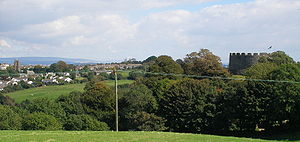- Trematon Castle
-
Trematon Castle is situated near Saltash in Cornwall, United Kingdom. It is similar in style to the later Restormel Castle, with a 12th century keep. Trematon Castle overlooks Plymouth Sound and was built probably by Robert, Count of Mortain on the ruins of an earlier Roman fort: it is a motte-and-bailey castle and dates from soon after the Norman conquest. It occupies a sentinel position one and a half miles south-east of Trematon village.
Contents
Description
Trematon Castle, like Restormel Castle, has a stone keep raised on an earlier motte. Although in ruins, much of the Norman walls remain standing, so that the original form of the Castle and keep are clear. The keep is oval and has walls ten feet thick and thirty feet high.[1] The internal diameter is approximately 21 metres. A rectangular gatehouse, built in 1270, has two floors and a portcullis. Both are in good condition.
The military historian Sir Charles Oman says of the castle's situation "Trematon is high aloft, on one of the summits of the rather chaotic group of hill-tops which lie behind Saltash and its daring modern bridge."[2]
Within the Castle courtyard stands a Georgian house built in about 1808. This has four reception rooms and six main bedrooms, as well as servants' quarters. Part of the original Castle wall was demolished to give this house a view into the surrounding countryside.[1]
History
The castle was established here by Robert, Count of Mortain soon after the Norman Conquest.[2]
From the Conquest until 1270, the rights for the ferry from Saltash Passage on the Plymouth side of the River Tamar to Saltash belonged to the Valletort family. When Roger de Valletort sold Trematon Castle and manor to Richard Earl of Cornwall, the rent was paid to the Earl's bailiff. In the thirteenth century, this amounted to nearly seven pounds sterling.
The Castle has remained the property of the Earls and Dukes of Cornwall without interruption since 1270, when Earl Richard bought it for £300.[1]
When Sir Francis Drake returned from his circumnavigation voyage in 1580, he came into harbour in Plymouth, then slipped out to anchor behind St Nicholas Island until word came from Queen Elizabeth's Court for the treasures he had gathered to be stored in Trematon Castle.[3] The horde consisted of gold, silver, and precious stones, mainly emeralds, the result of piracy from Spanish ships along the west coast of South America. Before being moved for storage in the Tower of London, the treasure was temporarily stored in the Golden Hinde.
In 1961 the Duchy of Cornwall advertised the Castle to be let on a full repairing lease for 21 years, with breaks, at a rent of £250 a year.[1] It subsequently became the home in Cornwall of Hugh Foot, Lord Caradon, and his son Paul Foot, a campaigning journalist, spent much of his youth there.[4] Lord Caradon's brother Michael Foot, the leader of the Labour Party from 1980–1983, was a frequent visitor to the castle.
Queen Elizabeth II visited the Castle on 25 July 1962 accompanied by the Lord Lieutenant of Cornwall, Sir Edward Bolitho, before driving to Fowey and embarking in HMY Britannia.[5]
The castle is currently closed to the public.
Manor of Trematon
Trematon appears in the Domesday Book (1086) as the manor of "Tremetone".[6] The manor was one of the 17 Antiqua maneria of the Duchy of Cornwall.[7]
Feet of Fines for Cornwall A.D. 1272 - 1307
Feet of Fines were final judgements regarding land after legal action had been taken. They provided a record of title, often after purchase.
The Manor and Castle of Trematon was the cause of a court case on 16 February 1270. Richard Plantagenet (created Earl of Cornwall 1226), the son of King John of England, was the claimant and Roger de Valle Torta the opponent regarding this land, 60½ knights fees in Devon and Cornwall, and the Manor of Calstock. The land was said to be the right of the said king as those which he had by Roger's gift.
Following the endorsement of this foot of fine it says: And Henry de la Pomerai and Peter Corbet put in their claim. This was saying that they did not agree with this decision and were lodging notice of their rights to the land. The argument was to continue for many years.
Additional details appear in the Fine Rolls Vol. 1 1272-1307 order: In 1274, the executors of Thomas' will were ordered to deliver to Peter Corbet, son and heir of Thomas Corbet, deceased, the lands which had belonged to his father. Peter was born in 1298, the son of Thomas, who died in 1300, and his first wife, Joan Mortimer.
A page note in the Feet of Fines confirms that Peter Corbet was the grandson of Isabella Corbet (formerly Valletort). This Peter, in 1315, was to petition Parliament for the recovery of the Trematon estate, alleging that when Roger de Valletort made a deed of gift in favour of Richard, Earl of Cornwall, he was non compos mentis.
References
- ^ a b c d 'Tenant Sought for Trematon Castle' in The Times dated March 1st, 1961, Issue 55018, p. 7, col. F
- ^ a b Oman, Sir Charles William Chadwick (1926) Castles, p. 107
- ^ Rowse, A. L. (1939) "History on the Hoe" in The Times dated November 11, 1939, p. 7. col. G
- ^ Paul Foot obituary from Daily Telegraph newspaper
- ^ 'Court Circular: H. M. Yacht Britannia' in The Times dated July 26, 1962, Issue 55453, p. 14, col. B
- ^ St Stephens-by-Saltash at genuki.org.uk
- ^ Hatcher, John (1970) Rural Economy and Society in the Duchy of Cornwall 1300-1500. Cambridge University Press ISBN 0521085500
- Hammond, Muriel (1963) Castles of Britain; I: England. London: Ian Allan
External links
Coordinates: 50°24′1.6″N 4°14′15.86″W / 50.400444°N 4.2377389°W
Categories:- Castles in Cornwall
- Military history of Cornwall
- Ruins in Cornwall
Wikimedia Foundation. 2010.

